Boosting Creativity During a Global Crisis: Strategies for Sustaining Creative Energy
Posted on October 5, 2021
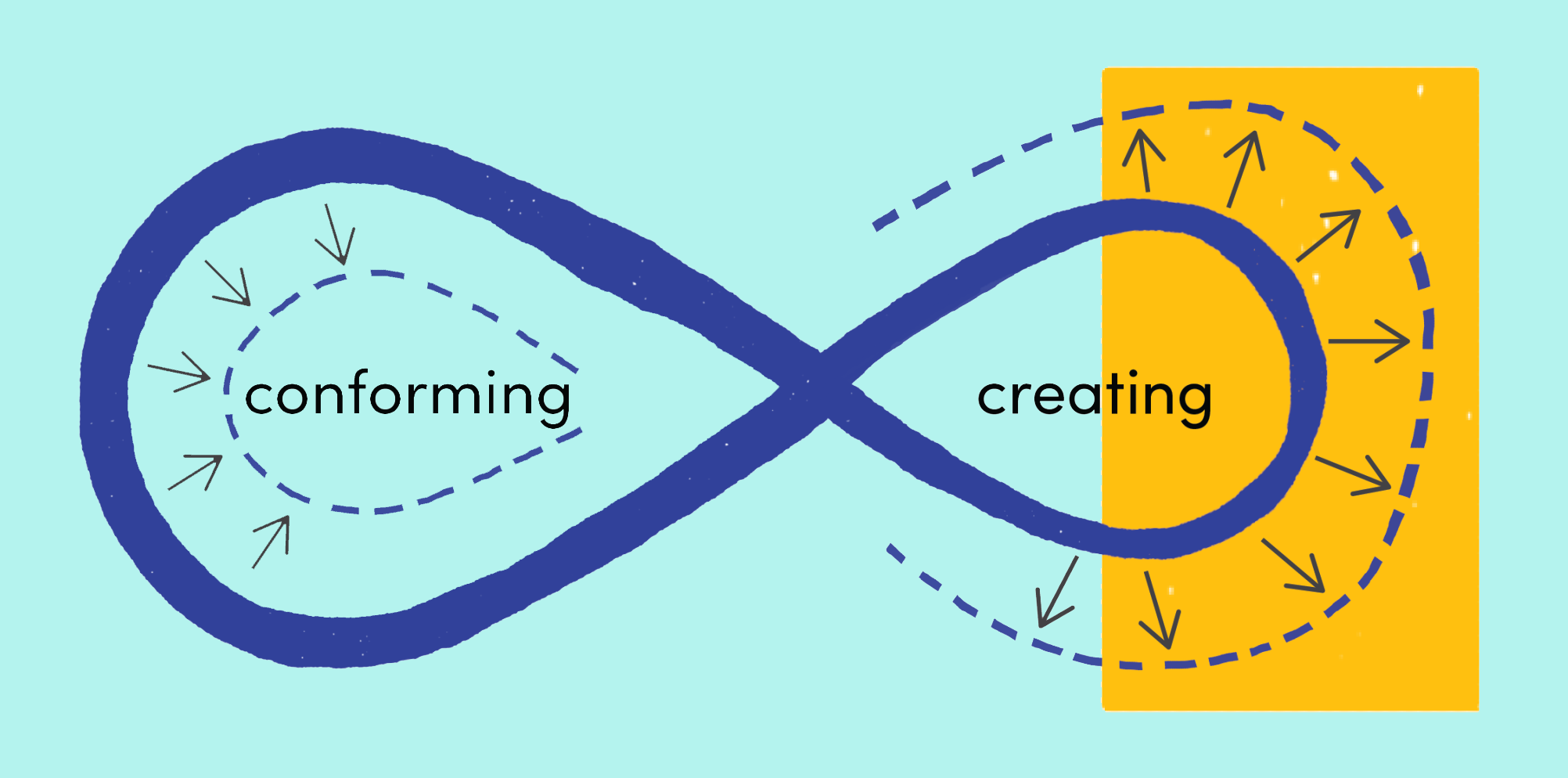
As part of our nature, humans are born into the world with two innate qualities that promote survival and growth. All humans are wired to find and follow patterns. We are innate conformists. This bias towards conformity has many advantages. It promotes cooperation, establishes norms, enables learning, and saves energy. To underscore the latter, we don’t need to think, problem-solve, or exert effort to learn something new when we follow an established pattern. Thus, we conserve energy, and in nature, energy is a precious resource.
However, if all we ever did were conform, there would be no growth or change. Thankfully, while all humans have been wired to conform, it is equally true to say that all humans have been wired to be creative. We have been bestowed with the higher-order thinking skills that enable us to imagine new possibilities and the physical dexterity to transform these original thoughts into reality. Humans, literally, are creativity machines.
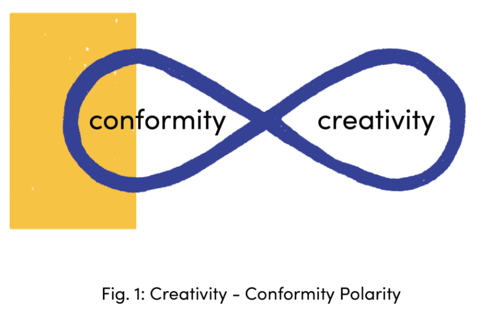
It is the union of these two predispositions that have allowed our species to survive and thrive. The dynamic interplay between conformity and creativity has enabled our species to spread across our planet. This is what I refer to as the Conformity-Creativity Polarity (see Figure 1). And it is precisely this polarity, a union of what seems to be opposing qualities, that is the competitive advantage for our species. Where we have the capacity to generate novel ideas (the creativity pole), we also possess the built-in ability to learn, to replicate, and to disseminate those novel ideas that work best (the conformity pole). It is the fluid and balanced movement between these qualities that is the fundamental driver to our success as a species.
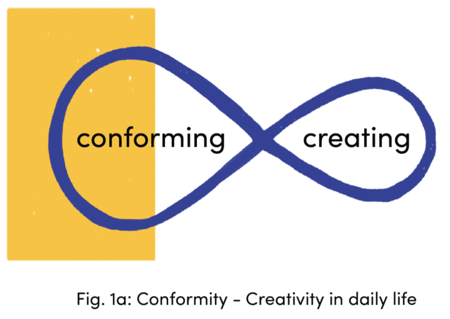
Crisis Crushes Conformity and Fuels Creativity
In reality, on a daily basis, and under normal circumstances, these qualities are not likely to be evenly balanced. I suspect that most of us spend more time conforming than creating, mainly sticking with what works and thinking in original ways only when necessary. Instead of the theoretical relationship shown in Figure 1, our daily lives are more likely to look like Figure 1a. That is, we engage in more conforming behavior than creating behavior. During a crisis, however, our survival instincts kick in, and we recognize that past patterns that evolved for one environment are no longer helpful in the face of change. A crisis often challenges established practices, think of social distancing before and during the pandemic. Given the fact that crisis crushes aspects of conformity, humans naturally shift focus and energy to their innate creating behavior. As illustrated in Figure 1b, during a crisis we will experience a creativity surge.
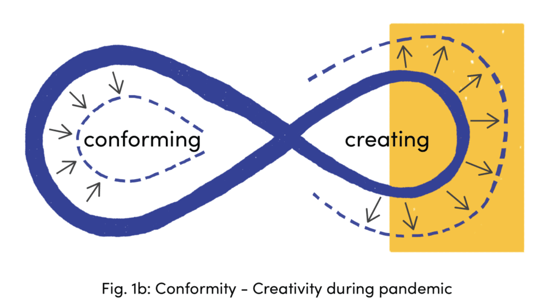
The pandemic, for the moment, has fundamentally changed our environment. The old ways of living and working have been thrown up in the air, forcing us to adapt and create new ways of being. Thus, the standard ratio of conforming to creating behavior in our daily lives has likely shifted, causing a surge in creativity. In light of the pandemic, consider the new behaviors that you may have adopted to socialize with others, to manage your home, to entertain yourself and your loved ones, or the alternative practices you have embraced to maintain work productivity.
Those most likely to survive and thrive economically through, and immediately after, the pandemic, are those ready to embrace their creativity surge. Last week, the New York Times published an article describing how some entrepreneurs are creatively responding to the pandemic to keep their businesses alive. For instance, where a 200-year-old shop for rare and fine wines historically drove sales mainly through in-person tastings and auctions, they now lead twice-weekly virtual tastings followed by online auctions. Orders through the shop’s website have shot up 300%. That’s taking more than two centuries of habits and patterns and replacing them with new approaches. Conformity is crushed by a crisis, and a lack of creativity leads to possible extinction.
Ways to Sustain Your Creativity
Feeling tired? Feeling fatigued? A creativity surge takes energy. It is all the new learning, new thinking, and need for imaginative responses that might have you feeling a bit exhausted.
During a creativity surge, it becomes crucially important to find ways to refresh and to fuel your creativity. With more than 30 years of experience in teaching, training, and studying creativity, I offer some simple strategies to sustain your creativity during a crisis.
1. Take a break. Allow your brain to rest. The brain is remarkably complex; even when you are not actively working on a problem, it still searches for solutions. And often, the most creative ideas occur to us while engaged in activities that are unrelated to the problems at hand. Great creators throughout history have recognized this and have built-in incubation breaks in their typical day of work (e.g., taking walks, going for a run, doing yoga, riding a bike, doing a crossword, making a puzzle, reading, cooking, etc.). The best kind of incubation break involves activities that are not cognitively demanding. In other words, activities for which you have fairly well-established patterns, thus allowing other parts of your mind to wander and to make new connections.
2. Shift your perspective. Change your frame of reference. Look at the challenge in a new way. Adopt a different perspective, how does the situation look from the perspective of another (i.e., end-user, child, parent, senior citizen, novice, expert, literary character, etc.).
3. Cross-fertilize ideas. The creative process is supercharged through analogies, metaphors, and simply transposing ideas from one setting to another. One of the best ways to generate a creative solution is to spot how analogous situations have solved a problem similar to yours (i.e., look to other fields, competitors, stories, nature, historical events, etc.). To promote metaphorical thinking, take time to expose your mind to information and ideas outside of your field, industry, or area of expertise. Our minds need to be fed novelty, and it is this outside novelty that just might catalyze new thinking and insights.
Eventually, things will get back to a regular rhythm and pace. Some energy will shift away from creating behavior to more conforming behavior. Still, because of the Corona-Creativity Surge, there will definitely be a new normal (See Figure 1c). And that’s how we, as a species, survive and thrive. When the environment changes, we adapt and change. That’s our competitive advantage. The question is, to what extent are you taking full advantage of your creativity surge?
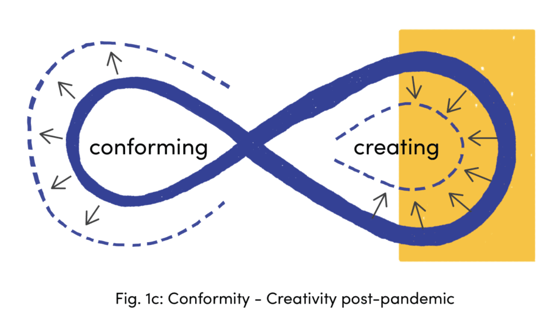
Author Gerard Puccio, PhD is the author of Creative Leadership and the FourSight® Thinking Profile and Chair of the International Center for Studies in Creativity at SUNY Buffalo State.
Gerard is the author of the FourSight assessment and co-founder of the FourSight company. For more than two decades, Gerard has chaired the department for Creativity and Change Leadership at the State University of New York where he recently earned “Distinguished Professor” status for his research and teaching in the field of creativity and problem solving.
Ready to learn more about FourSight?
Contact us today to learn more about our offer and how FourSight can help your teams work better together.
If you'd like to learn more about FourSight before scheduling a call, click below to learn about our platform and the science behind FourSight.
